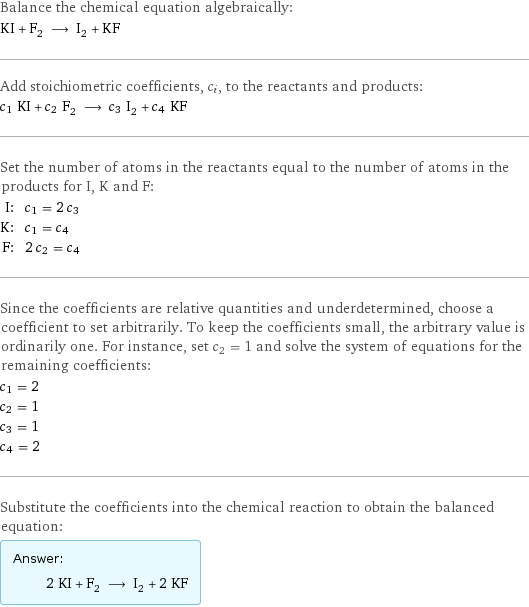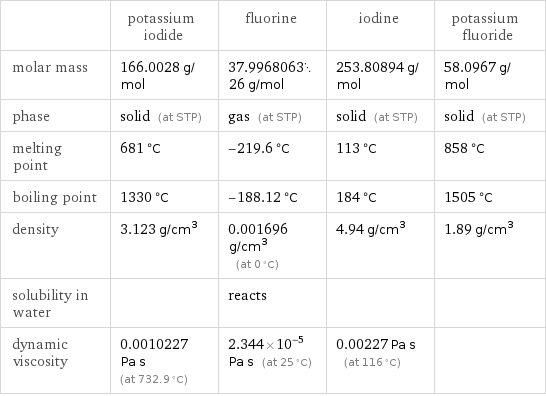Input interpretation

KI potassium iodide + F_2 fluorine ⟶ I_2 iodine + KF potassium fluoride
Balanced equation

Balance the chemical equation algebraically: KI + F_2 ⟶ I_2 + KF Add stoichiometric coefficients, c_i, to the reactants and products: c_1 KI + c_2 F_2 ⟶ c_3 I_2 + c_4 KF Set the number of atoms in the reactants equal to the number of atoms in the products for I, K and F: I: | c_1 = 2 c_3 K: | c_1 = c_4 F: | 2 c_2 = c_4 Since the coefficients are relative quantities and underdetermined, choose a coefficient to set arbitrarily. To keep the coefficients small, the arbitrary value is ordinarily one. For instance, set c_2 = 1 and solve the system of equations for the remaining coefficients: c_1 = 2 c_2 = 1 c_3 = 1 c_4 = 2 Substitute the coefficients into the chemical reaction to obtain the balanced equation: Answer: | | 2 KI + F_2 ⟶ I_2 + 2 KF
Structures

+ ⟶ +
Names

potassium iodide + fluorine ⟶ iodine + potassium fluoride
Reaction thermodynamics
Enthalpy

| potassium iodide | fluorine | iodine | potassium fluoride molecular enthalpy | -327.9 kJ/mol | 0 kJ/mol | 0 kJ/mol | -567.3 kJ/mol total enthalpy | -655.8 kJ/mol | 0 kJ/mol | 0 kJ/mol | -1135 kJ/mol | H_initial = -655.8 kJ/mol | | H_final = -1135 kJ/mol | ΔH_rxn^0 | -1135 kJ/mol - -655.8 kJ/mol = -478.8 kJ/mol (exothermic) | | |
Gibbs free energy

| potassium iodide | fluorine | iodine | potassium fluoride molecular free energy | -324.9 kJ/mol | 0 kJ/mol | 0 kJ/mol | -537.8 kJ/mol total free energy | -649.8 kJ/mol | 0 kJ/mol | 0 kJ/mol | -1076 kJ/mol | G_initial = -649.8 kJ/mol | | G_final = -1076 kJ/mol | ΔG_rxn^0 | -1076 kJ/mol - -649.8 kJ/mol = -425.8 kJ/mol (exergonic) | | |
Equilibrium constant
![Construct the equilibrium constant, K, expression for: KI + F_2 ⟶ I_2 + KF Plan: • Balance the chemical equation. • Determine the stoichiometric numbers. • Assemble the activity expression for each chemical species. • Use the activity expressions to build the equilibrium constant expression. Write the balanced chemical equation: 2 KI + F_2 ⟶ I_2 + 2 KF Assign stoichiometric numbers, ν_i, using the stoichiometric coefficients, c_i, from the balanced chemical equation in the following manner: ν_i = -c_i for reactants and ν_i = c_i for products: chemical species | c_i | ν_i KI | 2 | -2 F_2 | 1 | -1 I_2 | 1 | 1 KF | 2 | 2 Assemble the activity expressions accounting for the state of matter and ν_i: chemical species | c_i | ν_i | activity expression KI | 2 | -2 | ([KI])^(-2) F_2 | 1 | -1 | ([F2])^(-1) I_2 | 1 | 1 | [I2] KF | 2 | 2 | ([KF])^2 The equilibrium constant symbol in the concentration basis is: K_c Mulitply the activity expressions to arrive at the K_c expression: Answer: | | K_c = ([KI])^(-2) ([F2])^(-1) [I2] ([KF])^2 = ([I2] ([KF])^2)/(([KI])^2 [F2])](../image_source/349575c03c31ff7d8844e1315c356c24.png)
Construct the equilibrium constant, K, expression for: KI + F_2 ⟶ I_2 + KF Plan: • Balance the chemical equation. • Determine the stoichiometric numbers. • Assemble the activity expression for each chemical species. • Use the activity expressions to build the equilibrium constant expression. Write the balanced chemical equation: 2 KI + F_2 ⟶ I_2 + 2 KF Assign stoichiometric numbers, ν_i, using the stoichiometric coefficients, c_i, from the balanced chemical equation in the following manner: ν_i = -c_i for reactants and ν_i = c_i for products: chemical species | c_i | ν_i KI | 2 | -2 F_2 | 1 | -1 I_2 | 1 | 1 KF | 2 | 2 Assemble the activity expressions accounting for the state of matter and ν_i: chemical species | c_i | ν_i | activity expression KI | 2 | -2 | ([KI])^(-2) F_2 | 1 | -1 | ([F2])^(-1) I_2 | 1 | 1 | [I2] KF | 2 | 2 | ([KF])^2 The equilibrium constant symbol in the concentration basis is: K_c Mulitply the activity expressions to arrive at the K_c expression: Answer: | | K_c = ([KI])^(-2) ([F2])^(-1) [I2] ([KF])^2 = ([I2] ([KF])^2)/(([KI])^2 [F2])
Rate of reaction
![Construct the rate of reaction expression for: KI + F_2 ⟶ I_2 + KF Plan: • Balance the chemical equation. • Determine the stoichiometric numbers. • Assemble the rate term for each chemical species. • Write the rate of reaction expression. Write the balanced chemical equation: 2 KI + F_2 ⟶ I_2 + 2 KF Assign stoichiometric numbers, ν_i, using the stoichiometric coefficients, c_i, from the balanced chemical equation in the following manner: ν_i = -c_i for reactants and ν_i = c_i for products: chemical species | c_i | ν_i KI | 2 | -2 F_2 | 1 | -1 I_2 | 1 | 1 KF | 2 | 2 The rate term for each chemical species, B_i, is 1/ν_i(Δ[B_i])/(Δt) where [B_i] is the amount concentration and t is time: chemical species | c_i | ν_i | rate term KI | 2 | -2 | -1/2 (Δ[KI])/(Δt) F_2 | 1 | -1 | -(Δ[F2])/(Δt) I_2 | 1 | 1 | (Δ[I2])/(Δt) KF | 2 | 2 | 1/2 (Δ[KF])/(Δt) (for infinitesimal rate of change, replace Δ with d) Set the rate terms equal to each other to arrive at the rate expression: Answer: | | rate = -1/2 (Δ[KI])/(Δt) = -(Δ[F2])/(Δt) = (Δ[I2])/(Δt) = 1/2 (Δ[KF])/(Δt) (assuming constant volume and no accumulation of intermediates or side products)](../image_source/d692bda448beafa944dcdd9e1ea69dad.png)
Construct the rate of reaction expression for: KI + F_2 ⟶ I_2 + KF Plan: • Balance the chemical equation. • Determine the stoichiometric numbers. • Assemble the rate term for each chemical species. • Write the rate of reaction expression. Write the balanced chemical equation: 2 KI + F_2 ⟶ I_2 + 2 KF Assign stoichiometric numbers, ν_i, using the stoichiometric coefficients, c_i, from the balanced chemical equation in the following manner: ν_i = -c_i for reactants and ν_i = c_i for products: chemical species | c_i | ν_i KI | 2 | -2 F_2 | 1 | -1 I_2 | 1 | 1 KF | 2 | 2 The rate term for each chemical species, B_i, is 1/ν_i(Δ[B_i])/(Δt) where [B_i] is the amount concentration and t is time: chemical species | c_i | ν_i | rate term KI | 2 | -2 | -1/2 (Δ[KI])/(Δt) F_2 | 1 | -1 | -(Δ[F2])/(Δt) I_2 | 1 | 1 | (Δ[I2])/(Δt) KF | 2 | 2 | 1/2 (Δ[KF])/(Δt) (for infinitesimal rate of change, replace Δ with d) Set the rate terms equal to each other to arrive at the rate expression: Answer: | | rate = -1/2 (Δ[KI])/(Δt) = -(Δ[F2])/(Δt) = (Δ[I2])/(Δt) = 1/2 (Δ[KF])/(Δt) (assuming constant volume and no accumulation of intermediates or side products)
Chemical names and formulas

| potassium iodide | fluorine | iodine | potassium fluoride formula | KI | F_2 | I_2 | KF Hill formula | IK | F_2 | I_2 | FK name | potassium iodide | fluorine | iodine | potassium fluoride IUPAC name | potassium iodide | molecular fluorine | molecular iodine | potassium fluoride
Substance properties

| potassium iodide | fluorine | iodine | potassium fluoride molar mass | 166.0028 g/mol | 37.996806326 g/mol | 253.80894 g/mol | 58.0967 g/mol phase | solid (at STP) | gas (at STP) | solid (at STP) | solid (at STP) melting point | 681 °C | -219.6 °C | 113 °C | 858 °C boiling point | 1330 °C | -188.12 °C | 184 °C | 1505 °C density | 3.123 g/cm^3 | 0.001696 g/cm^3 (at 0 °C) | 4.94 g/cm^3 | 1.89 g/cm^3 solubility in water | | reacts | | dynamic viscosity | 0.0010227 Pa s (at 732.9 °C) | 2.344×10^-5 Pa s (at 25 °C) | 0.00227 Pa s (at 116 °C) |
Units
